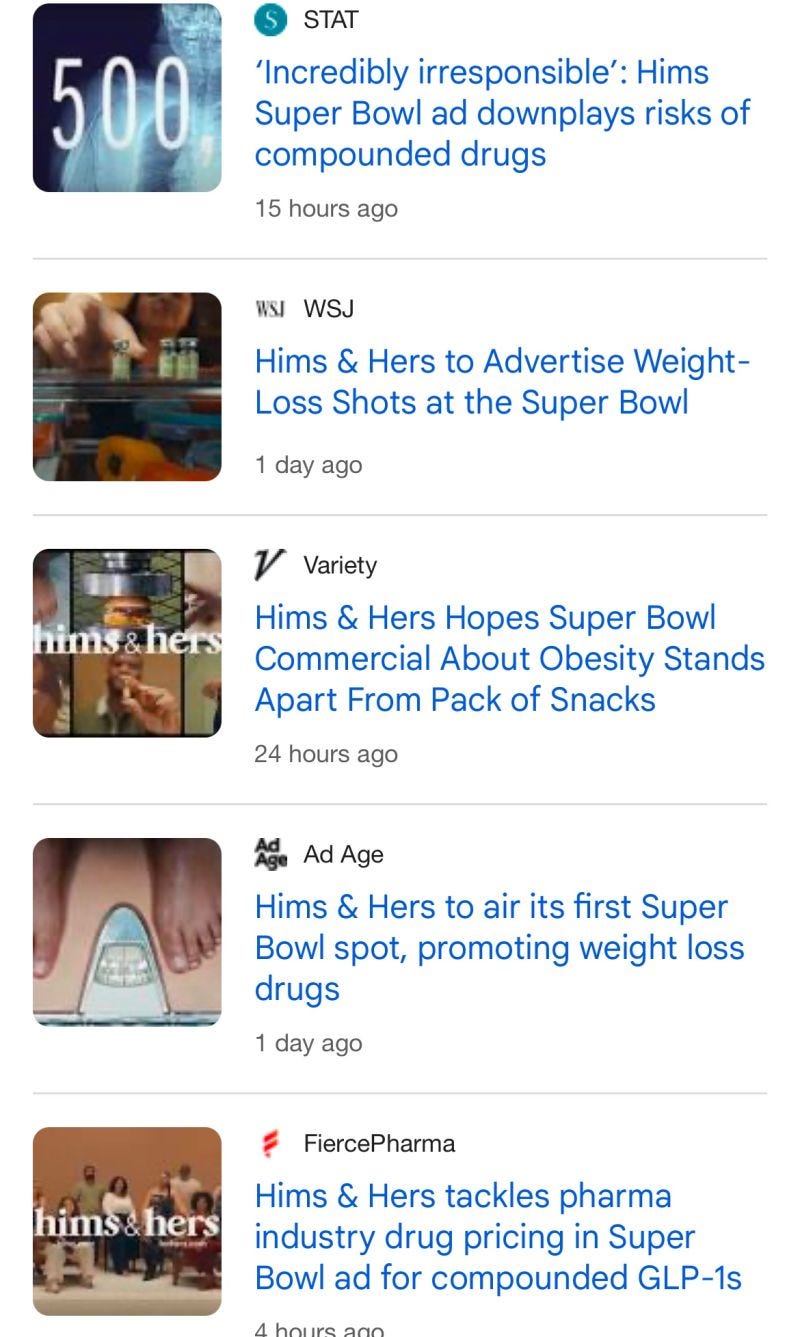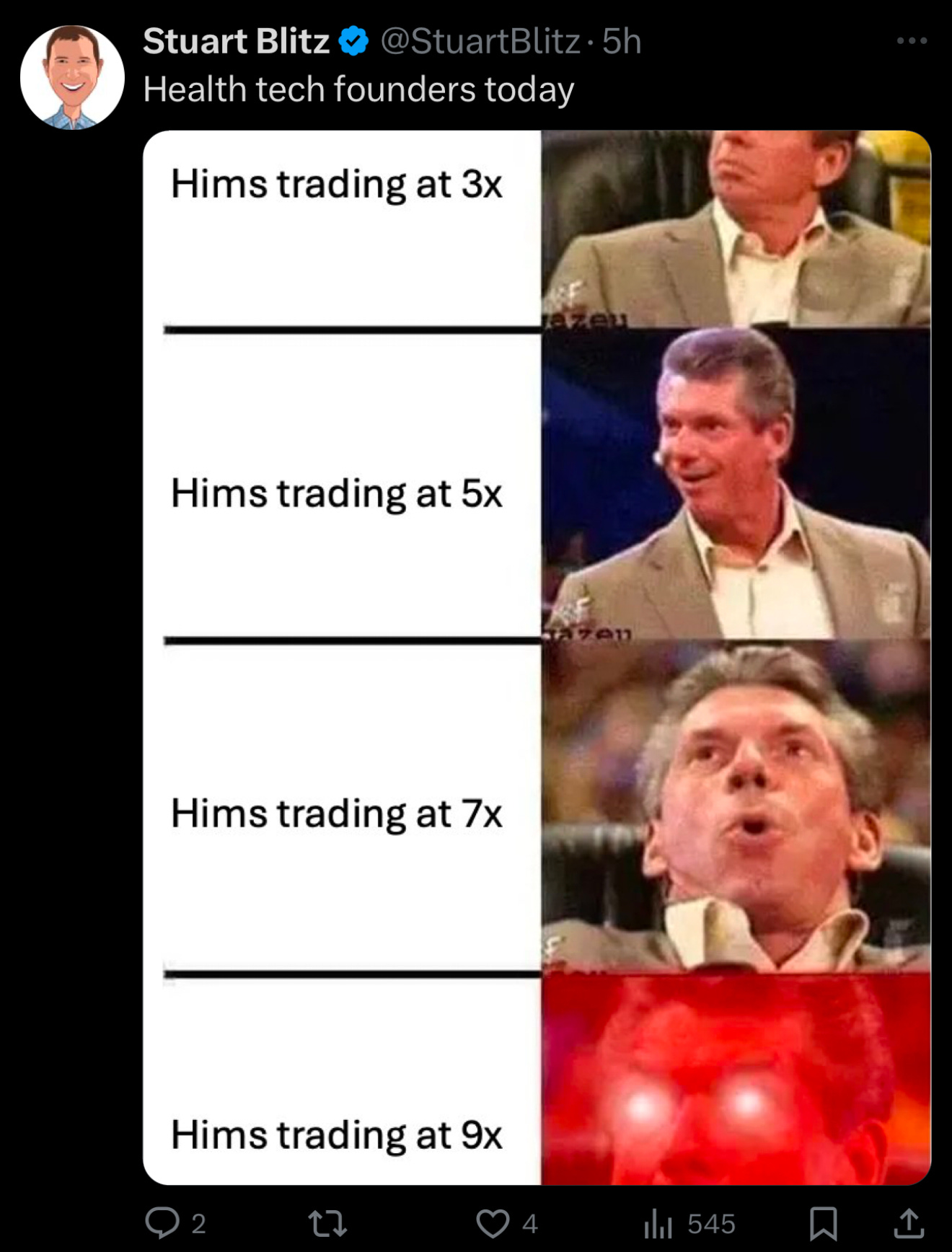Time to Sell Hims & Hers? The Super Bowl Short Selling Signal Says Yes
I list 12 once-famous companies that went bankrupt shortly after their expensive Super Bowl ads and other "champagne and cocaine" spending sprees.
Welcome to AI Health Uncut, a brutally honest newsletter on AI, innovation, and the state of the healthcare market. If you’d like to sign up to receive issues over email, you can do so here.
When a company starts blowing cash on Super Bowl ads like a VC bro at a strip club, it’s usually time to sell.
Disclaimer: I don’t own Hims stock, nor do I have any interest in its price direction—up or down.
Just as I predicted in my 2025 digital health outlook, we’re hitting peak GLP-1, and historically, reckless “champagne and cocaine” spending has been a flashing red sign that it’s time to walk away from a business pulling this kind of crazy sh*t.
There’s been wildly polarizing coverage of the upcoming Hims & Hers Super Bowl commercial featuring compounded semaglutide, commonly known as a GLP-1 weight loss injection.

We’ll see how it all plays out.
But it’s generally not a good sign when a company’s success hinges on a single product it doesn’t even produce—just resells, like everyone else!
And how cute is it that the media keeps calling Hims a “telehealth company”? Hims is not a telehealth company. It’s a reseller of someone else’s products. It’s no secret that Hims has always been a one-trick pony—whether it was male erections or weight loss—somehow managing to survive by hopping from one fad to the next. And to be fair, GLP-1 was the latest fad that actually helped Hims turn a profit. Not too shabby.
And now, Hims also got lucky with the Trump tariff wars, which hit its competitors much harder than Hims. How insanely lucky can one company be? Unbelievable.
Despite all this multi-year luck and finally turning a profit in 2024, I believe Hims’ glory days are numbered—just like all the other Super Bowl ad super-spenders that crashed and burned in stock market history.
The only thing giving me pause? Jim Cramer was bearish on Hims in yesterday’s show. That does not bode well for my prediction. 😊
Anyway, here’s a sample of companies that faced financial disaster or bankruptcy right after throwing cash at Super Bowl ads—especially in the 2000 Super Bowl, after which basically every “.com” company went bankrupt.
1. Just for Feet (Super Bowl Ad 1999 – Bankruptcy 1999/2000)
Super Bowl Ad: 1999 (Super Bowl XXXIII) – Just for Feet, a shoe retail chain, aired a controversial ad in which white hunters drugged a Kenyan runner to force shoes on him. (Source: bhamwiki.com.) The commercial was widely condemned as racist and insensitive, and even the company itself sued its ad agency over the fiasco (though it later dropped the suit). (Source: bhamwiki.com.)
Collapse: 1999/2000 – The ad debacle coincided with Just for Feet’s financial implosion. Burdened by $200 million in debt, the company missed a $12 million interest payment and filed for Chapter 11 bankruptcy in November 1999; by February 2000, it had entered Chapter 7 liquidation. A mix of a marketing disaster and underlying financial mismanagement (including an accounting fraud scandal) led to its rapid downfall. (Source: bhamwiki.com.)
2. Pets.com (Super Bowl Ad 2000 – Shutdown 2000)
Super Bowl Ad: 2000 (Super Bowl XXXIV) – Pets.com, an online pet supply startup famous for its sock-puppet mascot, ran a high-profile Super Bowl ad in January 2000 at the height of the dot-com boom. The ad gave Pets.com huge name recognition but also exemplified the era’s excessive spending. (Source: bizjournals.com.)
Collapse: 2000 – Less than a year later, Pets.com was out of business. The company went public in February 2000 but never turned a profit and burned through cash on marketing and infrastructure. By November 2000 – amid the dot-com crash – Pets.com had filed for bankruptcy and shut down operations. It became the poster child of dot-com bust excess, with a fundamentally flawed, unsustainable business model (expensive logistics for low-margin pet food sales). (Sources: bizjournals.com, investopedia.com.)
3. Epidemic.com (Super Bowl Ad 2000 – Folded 2000)
Super Bowl Ad: 2000 – Epidemic.com was another dot-com startup that bought a Super Bowl XXXIV spot. Its ad promoted a “viral” email marketing scheme (paying users to insert ads in personal emails). This unconventional concept got a big splash with the Super Bowl audience, but the company’s fortunes soon fizzled. (Source: businessinsider.com.)
Collapse: 2000 – By the end of 2000, Epidemic.com had folded. The company failed to secure a second round of funding to sustain itself. In an era when the dot-com bubble burst, short-term web traffic from a Super Bowl ad couldn’t save a business with no viable revenue model or investor support. (Sources: en.wikipedia.org, businessinsider.com, businessinsider.com.)
4. E-Stamp.com (Super Bowl Ad 2000 – Defunct by 2001)
Super Bowl Ad: 2000 – E-Stamp was a dot-com that aired a Super Bowl XXXIV commercial to tout itself as the first company authorized to sell U.S. postage stamps online. The ad aimed to legitimize the idea of buying postage via the internet at a time when that was new. (Source: businessinsider.com.)
Collapse: 2001 – The promise of E-Stamp didn’t last. The company went under by 2001, as it struggled to find enough customers and compete with larger rival Stamps.com, which ultimately acquired E-Stamp’s name and patents. Heavy Super Bowl ad spending couldn’t overcome E-Stamp’s inability to turn a profit in a nascent market. (Sources: businessinsider.com, en.wikipedia.org.)
5. LifeMinders.com (Super Bowl Ad 2000 – Sold Off 2001)
Super Bowl Ad: 2000 (Super Bowl XXXIV) – LifeMinders.com, an email-reminder startup, poured funds into a 30-second Super Bowl ad, which was widely panned and even labeled the “worst commercial” of 2000. The ad failed to generate meaningful customer engagement, despite the company’s belief in mass-scale internet advertising. (Sources: mentalfloss.com.)
Financial Collapse: 2001 – The dot-com bubble’s burst soon eroded LifeMinders.com’s value. The company struggled to generate sustainable profits and was forced into a fire-sale acquisition in mid-2001 for just ~$68 million—after once being valued in the billions. (Sources: mentalfloss.com, thehustle.co.)
6. OurBeginning.com (Super Bowl Ad 2000 – Defunct by 2002)
Super Bowl Ad: 2000 (Super Bowl XXXIV) – OurBeginning.com, an online stationery retailer, spent lavishly on Super Bowl advertising, allocating around $4 million of its $15 million ad budget in 2000 to a single Super Bowl spot. The company aimed for brand awareness but drastically overestimated its return on investment. (Source: mentalfloss.com.)
Financial Collapse: 2002 – The temporary revenue spike from Super Bowl visibility wasn’t enough to sustain the business. Advertising expenses vastly outpaced sales, and when the dot-com bubble burst, the company could not recover. By 2002, OurBeginning.com was out of its founders’ hands and sold, effectively marking its demise. (Source: mentalfloss.com.)
7. Netpliance (Super Bowl Ad 2000 – Folded 2002)
Super Bowl Ad: 2000 (Super Bowl XXXIV) – Netpliance, the maker of the “i-Opener” internet appliance, aired a Super Bowl ad in 2000 touting easy internet access without a traditional computer. The concept was ahead of its time, but the company’s business model was fundamentally flawed. (Sources: mentalfloss.com.)
Financial Collapse: 2002 – Netpliance attempted to sell its internet appliances at a loss, hoping to make up revenue through internet service subscriptions. This model proved unsustainable. By late 2000, the company halted hardware production and tried to pivot by licensing its technology to bigger firms, but it wasn’t enough. Netpliance eventually ran out of money and shut down by 2002. (Source: mentalfloss.com.)
8. Groupon (Super Bowl Ad 2011 – Crises by 2012/2013)
Super Bowl Ad: 2011 (Super Bowl XLV) – Groupon, a daily-deals startup, ran a Super Bowl ad in 2011 that tried to mix cause-related messaging with humor. The spot featured actor Timothy Hutton joking about the “troubles in Tibet” only to pivot into a pitch for half-off Tibetan food via Groupon. The ad was widely criticized as tone-deaf and in poor taste, overshadowing the company’s intent to gain positive brand awareness. (Source: marketingdive.com.)
Financial Troubles: 2012–2013 – Later in 2011, Groupon went public with a huge valuation, but its business began unraveling within a year. The company posted a disappointing loss in Q4 2011 and even had to restate its 2011 revenues downward in early 2012, raising serious investor concerns. By 2012–2013, Groupon’s stock had plummeted, and the CEO was ousted amid mounting losses. Rapid expansion, marketing missteps, and an unprofitable model led to severe financial difficulties within two years of its Super Bowl ad. (Source: en.wikipedia.org.)
9. BlackBerry (Super Bowl Ad 2013 – Collapse 2013)
Super Bowl Ad: 2013 – Research In Motion (renamed BlackBerry in 2013) bought its first-ever Super Bowl ad to promote the new BlackBerry 10 smartphone platform. This big-budget ad – a bid to revitalize the flagging BlackBerry brand – aired during Super Bowl XLVII. (Source: sportsbusinessjournal.com.)
Financial Troubles: 2013 – The comeback didn’t materialize. BlackBerry 10 sales flopped, and by late 2013 the company was in dire straits. BlackBerry took a massive $4.4 billion loss in the third quarter of 2013 as unsold phones piled up, with revenue plunging over 50% year-on-year. The crisis forced BlackBerry to abandon a planned sale of the company, replace its CEO, and lay off thousands of employees. The Super Bowl campaign couldn’t save BlackBerry from a rapid collapse in its market position against Apple and Android (Sources: theguardian.com, marketingweek.com).
10. RadioShack (Super Bowl Ad 2014 – Bankruptcy 2015)
Super Bowl Ad: 2014 (Super Bowl XLVIII) – In a bid to reinvent itself, RadioShack aired a much-buzzed-about Super Bowl ad in 2014. The ad joked “The ’80s called; they want their store back,” showing 1980s icons dismantling an old RadioShack, followed by the tagline “It’s time for a new RadioShack.” This nostalgic humor was meant to signal a modern makeover for the decades-old electronics retailer. (Source: ualrpublicradio.org.)
Collapse: 2015 – The Super Bowl reboot wasn’t enough. RadioShack’s sales kept declining as the company failed to shed its image as an outdated electronics seller. Just a year after the ad, in February 2015, RadioShack filed for Chapter 11 bankruptcy protection and began closing thousands of stores. The Super Bowl spot proved to be a last-ditch effort for a business model made obsolete by e-commerce and big-box competitors. (Source: ualrpublicradio.org.)
11. Quibi (Super Bowl Ad 2020 – Shutdown 2020)
Super Bowl Ad: 2020 (Super Bowl LIV) – Quibi, a heavily funded startup for short-form streaming content, launched with a Super Bowl ad in 2020. The 30-second spot (“Bank Heist”) introduced Quibi’s “quick bites” mobile video concept to the world. The company spent aggressively on marketing (over $60 million in its brief life) to drive downloads for its April 2020 debut. (Source: nfl.com.)
Collapse: 2020 – Barely half a year after launch, Quibi collapsed. By October 2020 – just six months in – Quibi announced it was shutting down entirely, returning capital to shareholders. The service failed to gain enough subscribers, due in part to an ill-timed launch (at the start of the COVID-19 pandemic lockdowns) and strategic missteps in its product approach. (Source: marketingdive.com.)
12. FTX (Super Bowl Ad 2022 – Bankruptcy 2022)
Super Bowl Ad: 2022 (Super Bowl LVI) – Cryptocurrency exchange FTX was riding high when it ran a star-studded Super Bowl ad in February 2022 (featuring comedian Larry David). (Source: english.elpais.com.)
Bankruptcy: 2022 – Within ten months, FTX imploded. A gaping hole in its balance sheet and misuse of customer funds spurred a rapid loss of investor confidence, triggering a run on deposits. FTX collapsed and filed for bankruptcy on November 11, 2022, and its founder Sam Bankman-Fried was later charged with fraud. (Sources: english.elpais.com.)
Many of these companies were either victims of the dot-com bubble, over-expansion, fraud, or simply couldn’t compete in changing markets. Their Super Bowl ads were often a sign of excess spending before their downfall.
They never learn, do they?
As I said, what sets Hims apart is that it’s actually profitable—it turned black for the first time in 2024.
But let’s be real: it’s a one-trick GLP-1 pony. As GLP-1 goes, so goes Hims. And in my view, GLP-1 is peaking.
🍕🍔🍻 Enjoy Super Bowl weekend! I hope your team wins! 🏆 And if you don’t have a team in this Super Bowl, at the very least, I hope you cash in on your company’s Super Bowl Squares. 💰 As for me, it’s been unbelievably tough rooting for the Dallas Cowboys while living in New York. 🏈 By the laws of the Super Bowl, I guess I’m obligated to root for the Chiefs on Sunday. 🤷
P.S. I’ve pushed my Hippocratic AI investigation to next week—too much dirt to sift through. My apologies. Now, I’m weaving in a narrative about the healthcare mafia because that’s exactly what it is. Hippocratic AI’s CEO is a made man in the “organization,” but still just a pawn compared to some of the real players. What a mess of an industry… Stay tuned—assuming I don’t get whacked first.
👉👉👉👉👉 Hi! My name is Sergei Polevikov. I’m an AI researcher and a healthcare AI startup founder. In my newsletter ‘AI Health Uncut,’ I combine my knowledge of AI models with my unique skills in analyzing the financial health of digital health companies. Why “Uncut”? Because I never sugarcoat or filter the hard truth. I don’t play games, I don’t work for anyone, and therefore, with your support, I produce the most original, the most unbiased, the most unapologetic research in AI, innovation, and healthcare. Thank you for your support of my work. You’re part of a vibrant community of healthcare AI enthusiasts! Your engagement matters. 🙏🙏🙏🙏🙏







